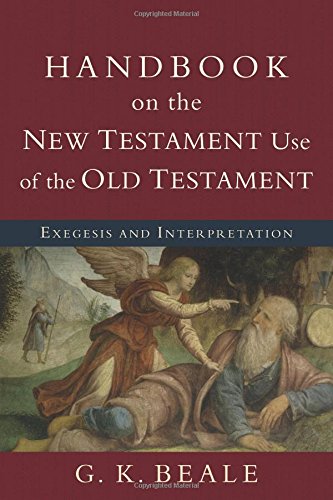A Brief Book Summary from Books At a Glance
About the Author
Gregory Beale is J. Gresham Machen Chair of New Testament and Biblical Theology at Westminster Theological Seminary, Philadelphia, PA. Since his dissertation on the use of Daniel in Revelation, Beale has been writing on the New Testament use of the Old Testament. He co-edited the Commentary on the New Testament Use of the Old Testament (Grand Rapids, Mich.: Baker, 2007) and has recently published his New Testament Biblical Theology: The Unfolding of the Old Testament in the New (Grand Rapids, Mich.: Baker, 2011). He is therefore ably equipped to write a handbook on the New Testament use of the Old Testament.
Introduction
Beale’s purpose is to “provide a short guide to the use of OT citations and allusions in the NT. The intended audience is serious-minded Christians, students, and pastors, with the hope that even scholars might benefit” (xvii). Rather than attempting thorough discussions of each topic in the book, Beale focuses on his own methodology for studying Old Testament quotations, allusions, and echoes, while discussing the tools needed for executing this task. The end of the book contains a select bibliography on this subject.
Table of Contents
Introduction
Chapter 1: Challenges to Interpreting the Use of the Old Testament in the New
Chapter 2: Seeing the Old Testament in the New: Definitions of Quotations and Allusions and Criteria for Discerning Them
Chapter 3: An Approach to Interpreting the Old Testament in the New
Chapter 4: Primary Ways the New Testament Uses the Old Testament
Chapter 5: Hermeneutical and Theological Presuppositions of the New Testament Writers
Chapter 6: The Relevance of Jewish Backgrounds for the Study of the Old Testament in the New: A Survey of the Sources
Chapter 7: A Case Study Illustrating the Methodology of This Book
Summary
Chapter 1
Challenges to Interpreting the Use of the Old Testament in the New
The most important debate in this area of research is whether the New Testament authors correctly interpret and utilize Old Testament texts. Various questions must be considered as one examines this debate. The first question is the extent to which Jewish interpretive methods influenced the New Testament authors. These Jewish interpretive methods are considered by many modern scholars to be illegitimate because they do not respect the context of passages that they cite or interpret. Those who believe the New Testament authors use such methods, and that such methods are illegitimate, either believe the authors are fallible in their interpretations or that they are still inspired. Texts that suggest the non-contextual use of the Old Testament fall into at least four different categories: (1) ad hominem argumentation; (2) non-contextual midrashic treatments; (3) allegorical interpretations; (4) atomistic interpretation.
On the other hand, some scholars hold that the New Testament authors use the Old Testament more or less contextually. The idea that Jewish exegesis was a major influence for the apostles is mitigated by the fact that most rabbinic exegetical examples come from after AD 70 and that one can often find contextual exegesis in Jewish apocalyptic writings and the Dead Sea Scrolls. Moreover, one cannot assume a priori that the apostles were influenced by Jewish exegetical methods and the New Testament’s use of the Old deserves to be examined first in its own right. C. H. Dodd’s study According to the Scriptures did just that. His study examined segments of the Old Testament cited multiple times in different parts of the New Testament (showing that different authors were drawn to similar parts of the Old Testament, often times the same verse), and concluded that the apostles were aware of broad contexts and did not proof-text single verses. Scholars are divided on their reception of Dodd’s work, but it is recognized as foundational in this field.
Another debate revolves around so-called testimonia, i.e., testimony books. J. R. Harris’ Testimonies argued for early sets of Old Testament texts that were pulled together as Messianic proofs. The apostles pulled their quotations from these proof-texting lists, which would suggest they were used non-contextually. Dodd’s argument for the contextual use of the Old Testament was in direct opposition to Harris’ thesis. The best view is that some lists probably did exist but that the authors also had access to actual Old Testament scrolls. They also would have committed passages of Scripture to memory….
[To continue reading this summary, please see below....]The remainder of this article is premium content. Become a member to continue reading.
Already have an account? Sign In
